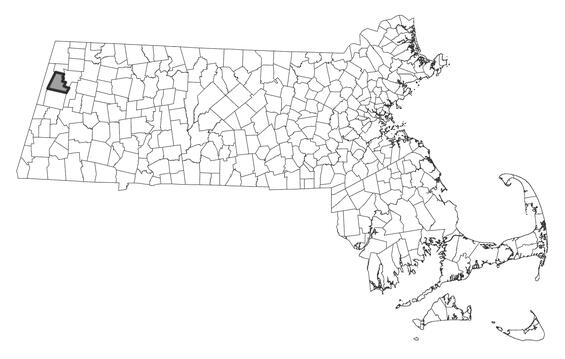- Scientific name: Rosa acicularis ssp. sayi
- Species of Greatest Conservation Need (MA State Wildlife Action Plan)
- Endangered (MA Endangered Species Act)
Description
The northern prickly rose is a low, few-stemmed shrub in the rose family (Rosaceae). It usually—and, in our area, always—grows less than 1 m (3.3 ft) tall. Its stems and branchlets are covered with numerous straight, very slender bristles that are 3-4 mm long. The compound leaves are alternate, with 3 to 7 (usually 5) leaflets. A pair of conspicuous stipules (vegetative appendages associated with leaves) occurs at the base of the leaf stalks; both the leaf stalks and the margins of the stipules are glandular. Northern prickly rose’s 1.5-4.5 cm (0.6–1.8 in) long leaflets are thin, serrate (with forward-facing teeth), and oblong-elliptic. Their surfaces are dull green above and paler green and minutely downy below. Flowers are generally solitary but may occur in groups of a few at the end of leafy branches. The pink petals are 2-3 cm (0.8-1.2 in) long and nearly as wide. The sepals (members of the outermost floral whorl) are glandular on the outside and often white and hairy inside. Northern prickly rose begins flowering in late May. Its fruit ("hip") is ellipsoid, often narrowly so, 2 cm (0.8 in) long, bright red, and many-seeded; hips ripen from late summer to early fall.
Northern prickly rose could be confused with the pasture or Carolina rose (Rosa carolina). However, pasture rose's prickles are paired at the stem/leaf nodes and are only scattered in between and are often of different sizes and shapes on the same plant, while bristles on northern prickly rose are all of a similar shape. In addition, pasture rose’s hips are globular, not elliptical. Like the northern prickly rose, the bog or shining rose (Rosa nitida) has slender prickles; in contrast, however, its fruits are globular, and it inhabits peat bogs and cold swamps. Northern prickly rose grows in thickets and on rocky slopes. The northern prickly rose is unique in Massachusetts in having distinctly elliptical hips; all our other roses have globular or somewhat pear-shaped hips.
Population status
In 1984, northern prickly rose was rediscovered in Massachusetts--after a lapse of 65 years. It is currently listed under the Massachusetts Endangered Species Act as Endangered. All listed species are protected from killing, collecting, possessing, or sale and from activities that would destroy habitat and thus directly or indirectly cause mortality or disrupt critical behaviors.
Massachusetts Natural Heritage & Endangered Species Program database has 2 records from 1 county (Berkshire). Only 1 of those records is within the last 25-year period.

Distribution in Massachusetts
1999-2024
Based on records in the Natural Heritage Database
Distribution and abundance
Rosa acicularis is a circumpolar species. In North America, the documented range of the subspecies extends from New Brunswick and Quebec to Alaska, south to Massachusetts, Pennsylvania, West Virginia, northern Illinois, Iowa, and northern New Mexico. NatureServe ranks northern prickly rose as G5, Secure. In the northeast where the subspecies is at the southeastern edge of the range, New York ranks it as Endangered. In New England, northern prickly rose is considered to be regionally rare, with five locations in three states.
Habitat
In general, northern prickly rose's habitats are thickets and rocky slopes. hop-hornbeam (Ostrya virginiana) is a fairly constant associated species throughout New England. In Massachusetts, the sole current station of northern prickly rose is an open, dolomitic limestone ledge at high elevation. Associated species at this site include shrubby cinquefoil (Dasiphora floribunda), choke cherry (Prunus virginiana), round-leaf dogwood (Cornus rugosa), various species of goldenrod (Solidago spp.), and two rare Massachusetts plants, Wall-rue spleenwort (Asplenium ruta-muraria) and purple clematis (Clematis occidentalis). An historical station in Massachusetts was near a mountain summit.
Healthy habitats are vital for supporting native wildlife and plants. Explore habitats and learn about conservation and restoration in Massachusetts.
Threats
In some years, plants at the current Massachusetts site have been observed to be heavily browsed, to the extent of limiting fruiting to inaccessible portions of the plants. However, the plants reproduce vegetatively as well as by seed and seem to tolerate being browsed.
Conservation
Sites should be monitored for browsing that causes decline and for invasions of exotic plants; if declines are apparent or exotic plants are crowding and out-competing this species, a plan should be developed, in consultation with the Masswildlife’s Natural Heritage & Endangered Species Program, to remove protect the plants or remove the invaders. All active management of rare plant populations (including invasive species removal) is subject to review under the Massachusetts Endangered Species Act and should be planned in close consultation with the Natural Heritage & Endangered Species Program.
References
NatureServe. 2010. NatureServe Explorer: An online encyclopedia of life [web application]. Version 7.1. NatureServe, Arlington, Virginia. Available http://www.natureserve.org/explorer. (Accessed: January 27, 2011 ).
Schori, A. 2003. Rosa acicularis ssp. sayi (Bristly, Needle-spine, or Prickly Rose) Conservation and Research Plan for New England. New England Wild Flower Society, Framingham, MA. Available from http://newfs.org/docs/pdf/Rosaacicularis.PDF
Contact
| Date published: | May 8, 2025 |
|---|